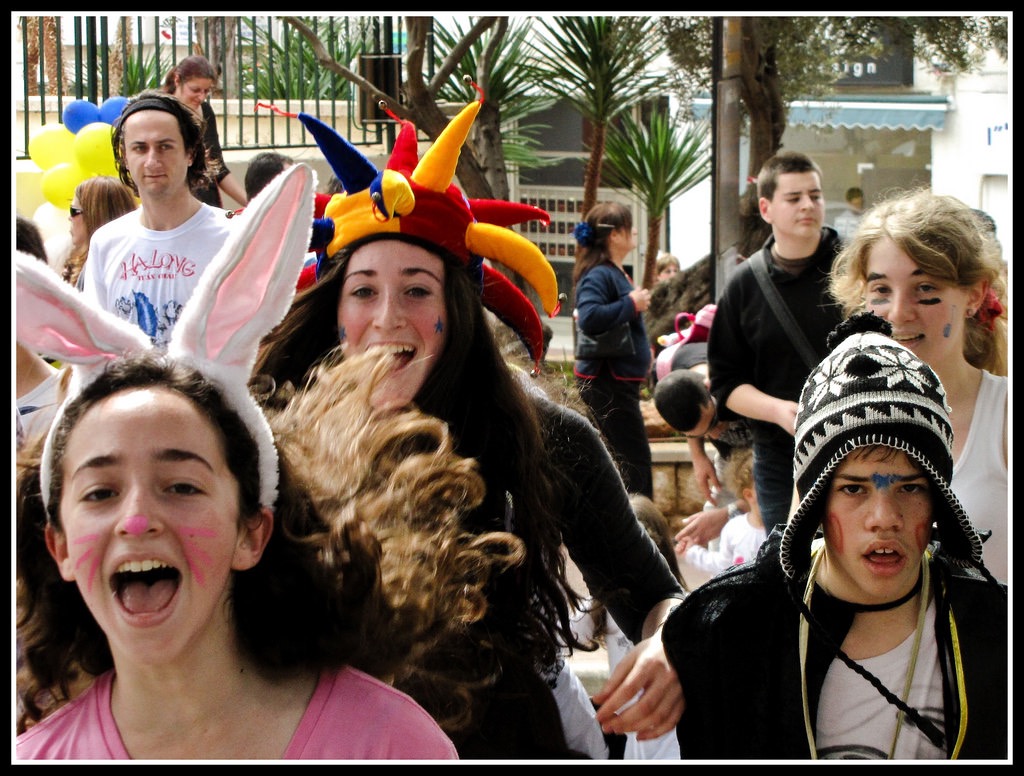 Children on Purim
Photo by Flavio
Grynszpan
Children on Purim
Photo by Flavio
Grynszpan One of the more challenging aspects of living an inspired life is experiencing meaning during those inevitable stretches that appear to be spiritually vacant. Many of us live our lives eagerly waiting for the next peak moment to arrive. We cross the days off our calendar in anticipation of the next big milestone, event or vacation, and we endure the hard days because we know something better lies ahead.
And, why not?
The approach seems harmless, maybe even therapeutic. It helps take the sting out of the everyday grind, and keeps us excited about our future: ten more days until the long weekend, a few weeks until my boss goes on a long vacation, one month until our family will all be under one roof again, the first time in years.
But, the mathematics here cause concern. Most of life, at least for me, exists somewhere between our significant highs and inevitable lows. If meaning only arrives when life crescendos, our fulfillment ratio won’t be pretty. Maybe once a week for the lucky ones, far more sporadic for the rest of us.
Recently, I caught myself absorbed in this kind of slump. As an educator, I live for the watershed moments of my classroom, of our institutional achievement, and of my teaching. If I could pull it off, I’d want everyday and everything in my life to be an earth-shattering experience – and why wouldn’t I? And so it’s not surprising that I’ve been struggling to find fulfillment absent a groundbreaking event. Although my job description includes teaching, learning, relationships and community building – things that should be naturally meaningful – if I allow each day and week to bleed into the next, these supposedly fulfilling tasks feel like… tasks.
I am fairly convinced that there are both many and no real ways to actually resolve this dilemma, but this year I’m finding some ‘Chicken Soup for the Soul’ in the duel strata of the Purim story.
The world of Megillat Esther is a famously godless one. Anomalous among the Torah’s many books, Esther’s ten chapters fail to mention God’s name, let alone attribute a divine hand in its topsy-turvy plot. The story itself begs the reader to be seduced by its fairytale style and too-good-to-be-true plot twists. With the absence of God’s presence, the story itself appears to be one of good fortune or luck: It just so happened that Mordechai was sitting at the king’s gate… It just so happened that Esther was chosen to be queen… It just so happened that Achashverosh opened up his diary to Mordechai’s page…
Indeed, the name of the holiday, חג פורים, a Holiday of Lots, appears to riff off of the story’s fluky plot. While all our other holidays commemorate the explicit hand of God in our national history, a cursory reading of the Purim story offers a worldview that’s whimsical and arbitrary. Something like: in a world without God, Chance reigns.
But of course, our Holiday of Lots is grounded in a Scroll of Hiddenness, מגילת אסתר. While the first-layer of the Megillah tempts us into seeing the world as if things just happen, I believe the Megillah wants us to dismiss that view as artificial. Instead, the Megillah challenges us to develop a religious consciousness, a spiritual acumen willing to find meaning, God, and godliness even when its presence isn’t immediately obvious. Different than our other biblical stories, Megillat Esther raises the ante and demands that we become active and engaged seekers of God, rather than mere consumers. Meaning is unavoidable at the birth of one’s child; it takes a bit more effort to find it while paying your taxes.
I love this idea, but it’s also demanding. The hidden theology of Megillat Esther requires us to search actively for meaning and to work to uncover God’s presence in the world. It encourages us to be suspect of appearances, and instead value the deeper layers of soul, purpose, and intent.
On one level, we wear costumes on Purim to accentuate the carnivalesque nature of the day. Yes, Jews can party, too. But on a deeper level, our costumes are meant to express our less revealed selves, the hidden layers of our persona that tend to be a bit more concealed. Amidst the merriment and joy of Purim, we simultaneously affirm that there’s always more than meets the eye. Ironically, though in typical Jewish fashion, the Purim costume is actually meant to subvert the outer world in favor of revealing our inner-world. (So, choose your costume wisely!)
Herein lies the great work of the Purim season. Revisit an aspect in your life that feels perfunctory and reflect on its purpose, reignite a relationship that’s stultifying by identifying its real worth, and try to remind yourself that peak moments are always lurking, we just need to do a better job opening our eyes.
Purim Sameach.
Ari Schwarzberg is Director, The Shalhevet Institute and Judaic Studies Faculty at Shalhevet High School in Los Angeles.























 More news and opinions than at a Shabbat dinner, right in your inbox.
More news and opinions than at a Shabbat dinner, right in your inbox.